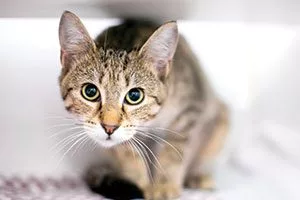Ringworm. The name suggests that your cat has some kind of worms inside of them, but this is not the case. Ringworm is a highly contagious fungal skin infection that can spread to other animals, as well as humans. Its name comes from the ring-like rash it creates on the skin.
As concerning as it can be to suddenly see signs that your cat has ringworm, there is no need to panic. There are many possible treatment solutions, and for the most part, ringworm is relatively non-threatening, especially if it’s treated quickly. Continue through our Crown Point, IN, animal hospital’s blog post to find out more.
What is Ringworm?
Before diving into the causes and the signs that your cat has ringworm, it is best to start with the basics. What is ringworm? Ringworm is a skin disorder and fungal infection caused by fungi known as “dermatophytes.” These tiny organisms can be found in soil, but they may also live in other environments.
Ringworm is characterized by the itching sensation it creates in those affected, and it can make the skin scaly as well. Your cat will scratch and lick relentlessly at this itchy area, which can damage their skin barrier and lead to secondary bacterial infections.
The Common Causes of Ringworm
There are a couple of different ways that cats can become infected with ringworm, though the infection itself has one main cause, which we explain below.
Dermatophytes
Dermatophytes are the primary cause of ringworm in cats. To thrive, dermatophytes consume keratin on the body (keratin is a protein building block of hair and nails), and then reproduce and generate millions of spores. This makes ringworm extremely easy to catch.
Close Contact
Cats living in shelters or on the streets are more likely to become infected with ringworm. In addition to being in close quarters, grooming one another can also contribute to the spread of infection.
Self-Grooming
Some cats spread the bacteria or fungus to themselves as they lick the wounds and the red marks left behind by the ringworm infection.
Indirect Exposure
Another cause of ringworm is indirect exposure (i.e., not from a cat). For example, if you have a blanket or other material that has touched the skin of a cat infected with ringworm, this can transfer to your cat’s skin. Always clean your sheets, bedding, and fabric furniture when exposed to infections.

4 Signs Your Cat has Ringworm
Hair Loss in Patches
Ringworm causes the affected area of skin to become irritated and raised. This itchy patch of skin will likely invite incessant scratching from your cat, which can in turn result in noticeable hair loss. It is likely you will see circles of hair loss in patches. Fortunately, with treatment, this hair will grow back.
Circular Red Marks
Other than an overall loss of hair, it is also common to see a bright red ring mark on the surface of your cat’s skin. This ring is caused by the infection and slightly resembles a roundworm. This ring of skin is itchy and can become extremely irritated.
Scaling Skin
As your cat’s skin dries out, they are likely to be left with scaly skin. Your cat’s scaly skin is uncomfortable and can cause them to scratch. This is an autoimmune system response to fungal bacteria. As new growth of skin grows rapidly under the dry skin, this causes your cat to feel itchy and scratch to get relief, which releases flaky white dandruff.
Crusting Skin
Crusting skin is more common when your cat has accidentally opened a wound on its skin, and the wound begins to dry out. This crust can also be dried pus that comes out of infected areas.
Diagnosing Ringworm
To properly diagnose ringworm in your cat, your veterinarian will first need to examine them and count out other potential problems that may resemble the appearance of ringworm. If you notice your cat scratching and licking at themselves, assume ringworm could be a possibility and alert your veterinarian as quickly as possible.

Treating Ringworm in Cats
While you can wait for the symptoms to go away naturally, this can take 9 months to a year, or more. During this time, your cat may be able to spread ringworm to you and other pets around them. Fortunately, ringworm is treatable, though treatment can take from 6 weeks to several months, depending on the severity of your pet’s condition and their response to the treatments they receive.
Your cat’s ringworm treatment will likely include applying a medicated antifungal ointment to the areas of infection. A systemic medication may be needed as well. For ringworm that affects multiple areas of the body, we may also recommend a full-body rinse or dip to treat your pet’s skin. During the course of their treatment, it’s important to try to keep your cat from licking at the ointment.
Seek Immediate Care for Your Cat in Crown Point, IN, if You Suspect Ringworm
Ringworm is an uncomfortable, highly contagious infection that can cause severe itching of the skin, hair loss, scaly skin, and dandruff. Because ringworm is zoonotic, having an infected pet in your home can result in you or another family member becoming infected with ringworm as well. Be proactive and contact your vet if your cat’s behaviors resemble the symptoms of ringworm so they can be treated right away!
If you suspect ringworm in your cat, please stop by our Crown Point animal hospital or give us a call at (219) 267-1700.




